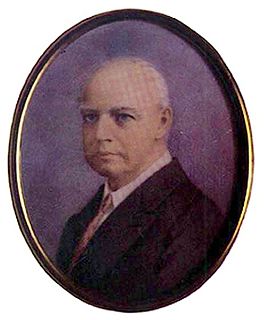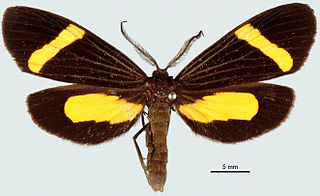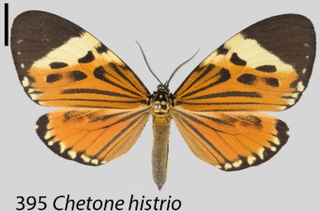
Pedro de Aycinena y Piñol was a conservative politician and member of the Aycinena clan that worked closely with the conservative regime of Rafael Carrera. He was interim president of Guatemala in 1865 after the death of president for life, general Rafael Carrera.

Hypena is a genus of moths in the family Erebidae. It was first described by Franz von Paula Schrank in 1802. These non-migratory moths overwinter as pupae and almost never estivate as adults.

Chetone is a genus of tiger moths in the family Erebidae. The genus was erected by Jean Baptiste Boisduval in 1870.

Cosmosoma is a genus of tiger moths in the subfamily Arctiinae. The genus was erected by Jacob Hübner in 1823.

The Aganainae are a small subfamily of moths in the family Erebidae. The adults and caterpillars of this subfamily are typically large and brightly colored, like the related tiger moths. Many of the caterpillars feed on poisonous host plants and acquire toxic cardenolides that make them unpleasant to predators. Like the closely related litter moths, the adults have long, upturned labial palps, and the caterpillars have fully or mostly developed prolegs on the abdomen. The Aganainae are distributed across the tropics and subtropics of the Old World.

Virbia is a genus of tiger moths in the family Erebidae. The genus was erected by Francis Walker in 1854.

Temnora is a genus of moths in the family Sphingidae.

Lyces is a genus of moths of the family Notodontidae erected by Francis Walker in 1854. It consists of the following species:

Ategumia ebulealis, the clidemia leafroller, is a moth of the family Crambidae. The species was described by Achille Guenée in 1854. It is found in Central America, the Antilles, and the south-eastern United States. It was thought to be introduced to Hawaii, but later research concluded it was actually Ategumia matutinalis which was released.

Stericta is a genus of snout moths. It was described by Julius Lederer in 1863.

The Pericopina is a subtribe of tiger moths in the family Erebidae. The subtribe was described by Francis Walker in 1869.

Chetone catilina is a moth of the family Erebidae. It was described by Pieter Cramer in 1775. It is found in French Guiana, Venezuela and Suriname.
Chetone decisa is a moth of the family Erebidae. It was described by Francis Walker in 1854. It is found in Colombia.

Chetone histrio, or Boisduval's tiger, is a moth of the family Erebidae. It was described by Jean Baptiste Boisduval in 1870. It is found in Honduras, Guatemala and Peru.

Chetone salvini is a moth of the family Erebidae. It was described by Jean Baptiste Boisduval in 1870. It is found in Central America.
Chetone histriomorpha is a moth of the family Erebidae. It was described by Hering in 1925. It is found in Ecuador.

Cosmosoma festivum, the festivum wasp moth, is a moth of the family Erebidae. It was described by Francis Walker in 1854. It is found in Mexico, Guatemala, Belize, Costa Rica and Honduras. It has also been recorded in southern Florida and southern Texas.















